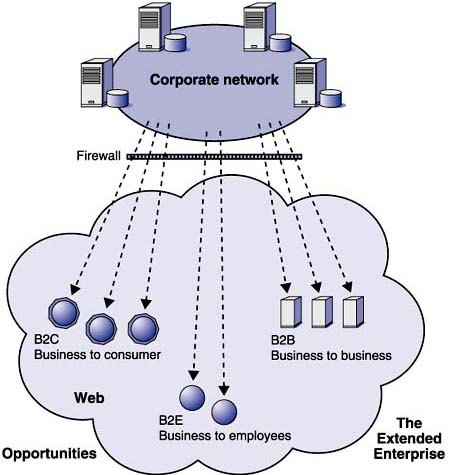| The Web has opened up new possibilities for engagement. | The story behind XML is very much the story of the Web. In just a few short years the Web has affected almost every aspect of our lives, from work, to play, to social interaction. However, until recently, the Web's impact has been primarily on individuals, providing a quick and efficient way to check email, search for information, and buy things online. The global scope of the Web and its possibilities have not gone unnoticed by companies looking to gain competitive advantage. This global connectivity, coupled with accepted Internet standards for communication, has spawned new ideas about how to leverage this new capability. | The extended enterprise includes B2C, B2B, and B2E interaction. | As Figure 1.1 illustrates, there are three major aspects to extending the enterprise from a relatively constrained network to the broad reach of the Web. The most commonly considered aspect is the business-to-consumer (B2C) connection, exploiting opportunities that abound in online commerce. Another area is the business-to-employee (B2E) connection, adding efficiencies in operations and customer contact by using the Web instead of proprietary networks. A third area, and one of particular interest to businesses trying to survive in competitive environments, is the business-to-business (B2B) connection made possible by the Web. Together, these opportunities are driving what is seen as the extended enterprise, a mix of traditional networks and the loose space of the Web. Figure 1.1. The extended enterprise combines traditional networks with the power of the Web, opening up new opportunities in B2B, B2C, and B2E commerce.  | Data is the key to the extended enterprise. | But to turn these possibilities and visions of global connectedness into a reality requires data, not only for the consumer, but for employees who need data and information to do their jobs wherever they are, and for the B2B transactions that are the essential ingredient for partners and suppliers. That's where XML comes in.  |



